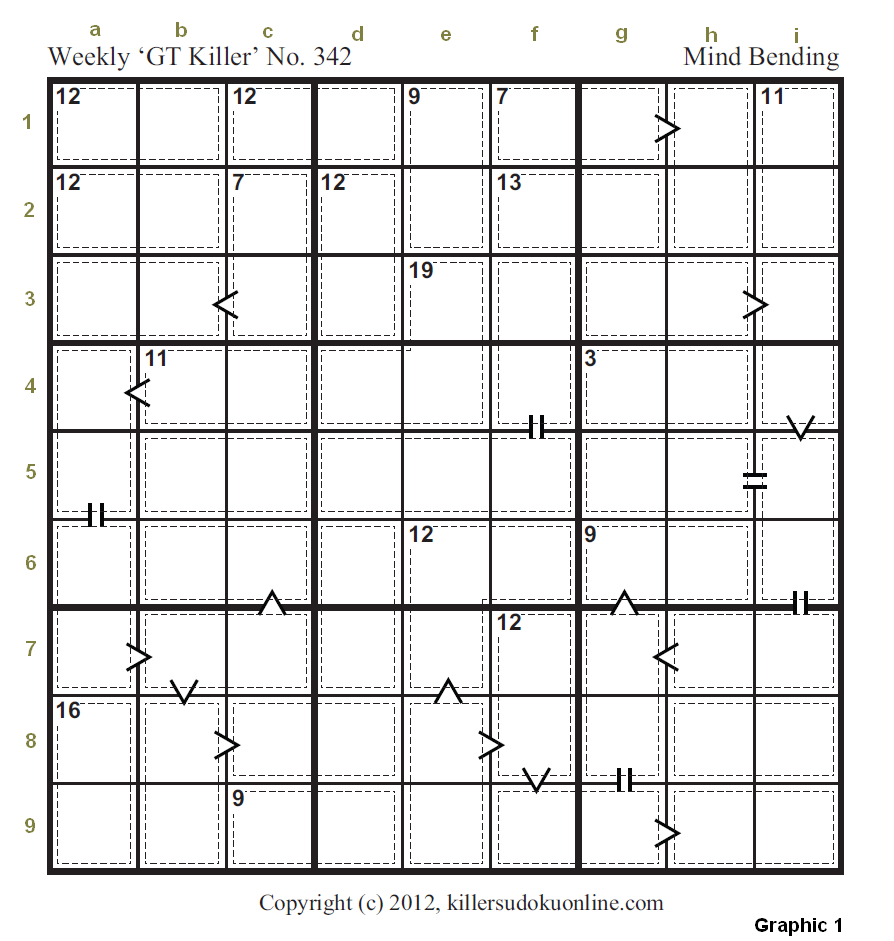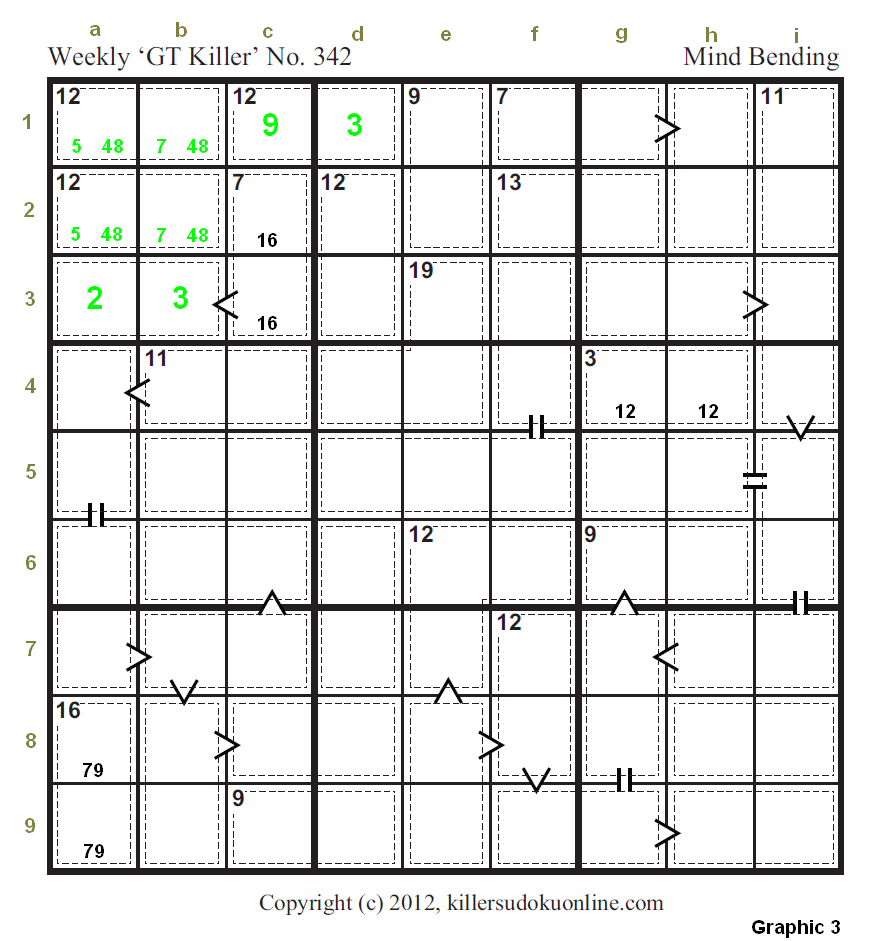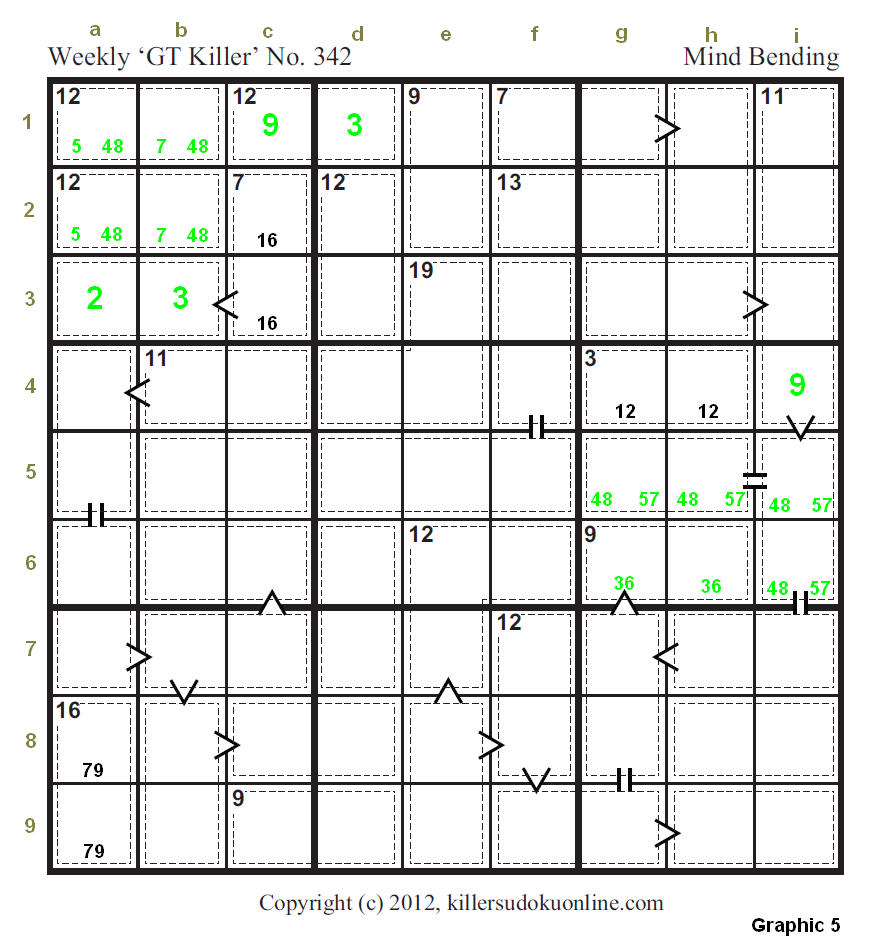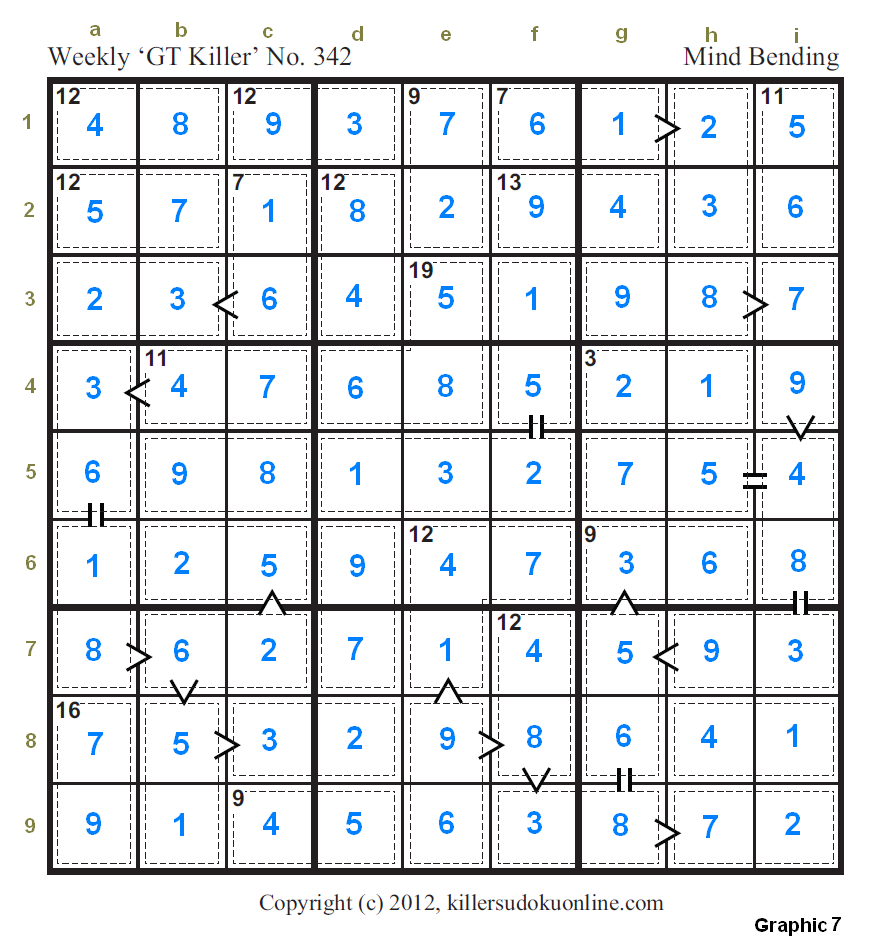Killer Sudoku with inequalities: A few tips. In general, a
Killer Sudoku with inequalities (the signs <, >, =, compare the value of the individual cells or cages involved; this example comes from the site
killersudokuonline.com where they name it
Greater Than Killer Sudoku) should be more difficult (requiring more time) than the Standard Killer Sudoku since it contains less information (in this example we have 22 “blind” cages containing 45 numbers while the 17 “normal” cages contain the other 36 numbers):

Next (Graphic 2): We can inmediately place the candidates for cages “3” (g4-h4), “16” (a8-a9) and “7” (c2-c3) = [1,6], this last result because a 6 cann’t be in a 2-cell cage “12” and it’s not possible in the cage a3-b3 since this cage would have a minimum value of 7 and then it could not be strictly lower than 7 (cage “7” in c2-c3).
Now, where and how can we “open the can”?. We may start with nonet N1: c1 + a3 + b3 = 45 – 12 – 12 – 7 = 14; the possibilities are: c1 = 8, a3-b3 (+) = 6 and c1 = 9, a3-b3 (+) = 5. We analyze the first possibility (numbers in red colour):

If c1 = 8 the cages “12” in a1-b1 and a2-b2 must be [3,9] and [5,7] (the exact position undefined yet) but being “16” (a8-a9) = [7,9] obviously a1-a2 would be [3,5] and a3-b3 = 6 = [2,4]. We use the parity rule to see that this situation would be invalid because the sum a1 + a2 + a3 would be even (10 or 12); since the cages a4-a5 and a6-a7 have the same value >>> twice that value is even, and “16” is also even, so a1 + a2 + a3, which is the difference to 45, the total for column “a”, must be odd.
So we conclude that (Graphic 3, numbers in green colour) c1 = 9 (then the “12” cages are [4,8] and [5,7] as shown) and a3-b3 = 5 = [2,3]. Even more: a3 = 2 (and not a3 = 3), it must be even to comply with the condition a1 + a2 + a3 = odd (a1 + a2 is 5 + 4 = 9 or 5 + 8 = 13). From this point the full puzzle can be solved, I recommend you to do it, it’s very amused.

But let’s continue a little bit.
Do you think we could have “opened the can” from any other point?. Let’s see, for instance, the case of N6 (Graphic 4):

We start with numbers in blue colour: The cell i4 is odd (45 – 3 – 9 – even number, being the sum of two cages with equal value obviously even). Then, initially, the possibilities are [3,5,7,9]. Clearly 3 is not valid because the value for the equal cages would be 15 and there is no number for i3 such that i3 + 3 > 15. Also a 5 is not valid for i4: the value of the equal cages would be 14 but one of them requires to be [5,9]; or, from another point of view, the maximum value for i3 is 9 and the maximum value for the cage i3-i4 would be 14 which is not strictly higher than the obtained value (14) for the cage i5-i6.
The hypothesis i4 = 7 is more interesting (numbers in red colour): Now the value of the two equal cages is 13 >>> i3 = 8 (and only 8 otherwise with i3 = 9 >>> g3-h3 (+) = 17 = [8,9] and the 9 would duplicate) >>> g3-h3 = [7,9] (unique) >>> “11” (i1-i2) = [5,6] >>> “13” (i5-i6) = [4,9] >>> and the cage h7-i7, which following this hypothesis is supposed to have a value of 13, could not be done.
So we have arrived to the conclusion that i4 = 9, the two equal cages have a value of 12, that is, [4,8] and [5,7], and “9” (g6-h6) = [3,6]. We show this in the next Graphic (5) in green colour:

We can see more curious things, applying the logic (Graphic 6). Let’s deduce the candidates for the cages a4-a5 and a6-a7. If a1-a2 = [5,8] >>> the cages in blue would have a value of 7, that is, (45 – 15 – 16) / 2, in this case the cage in gray colour (b7-c7) has a value of 6 and the cage in yellow colour (b8-b9) a value of 5 or 4 (for instance, 5 and 4, respectively, for those cages is invalid since there is no way of obtaining a sum of 9 with four different numbers inside N7). These two cages then containing [1,2,3,5] or [1,2,3,4] but now the cage in brown colour (c8-d8) has a value of 4 or 3 but neither [1,3] or [1,2] is possible.
Then a1-a2 is [4,5] (we erase the 8 as a candidate in those positions) and the cages in blue colour have a value of 9, that is, (45 – 11 – 16) / 2, consequently a6-a7 = [1,8] (the combination [3,6] is not possible due to g6-h6) and a4-a5 = [3,6].
Since there is a 9 in c1 and a 9 in the cage “16” (a8-a9), the 9 of column “b” must go to b5 or b6 (b4 is inhibited by i4 = 9). But the maximum possible value of the cage b6-c6 is 7 (lower than b7-c7 which is lower than a6-a7) so b5 = 9.

I recommend you to enjoy the solution of this puzzle by using strategies like the above described, using the inequalities, though the puzzle can be solved in a straight manner continuing from nonet N2.
The last curiosity:
Do you think that the 1 of cage a6-a7 could go to a7?.
I provide my solution (for future reference, though perhaps it could be recovered from the referenced site):







